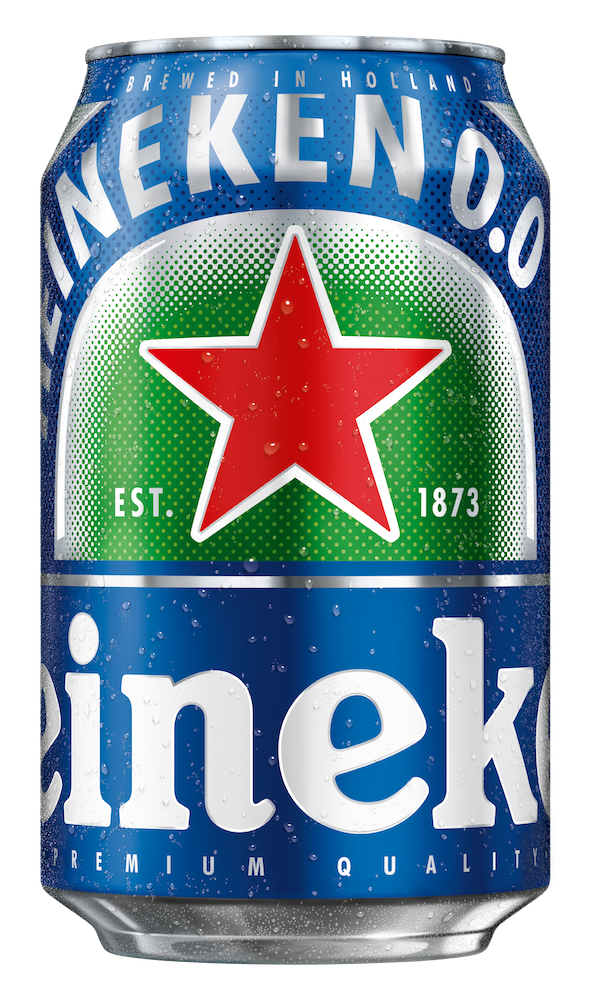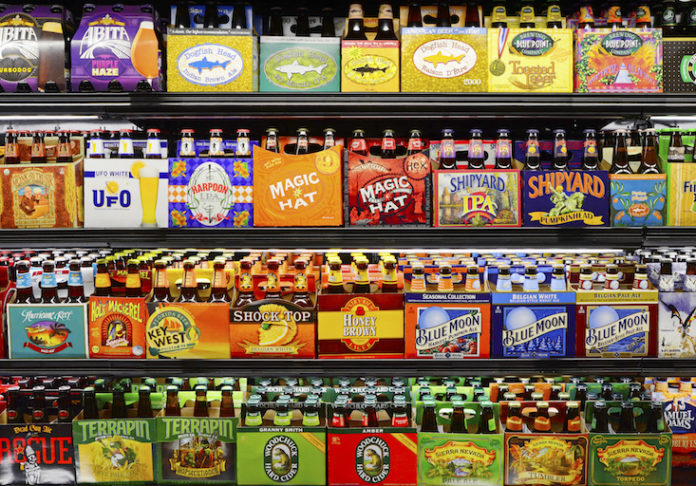We calculated our annual Beer Growth Brands Awards a bit differently in 2019.
This year we polled beverage alcohol retailers and other industry professionals about what brands and companies sold the best in 2018, while also helping define the beer category as a whole.
The responses we received helped paint a picture of what consumers most prefer nowadays when buying brews.
Macro Still Means Dollars
Unsurprisingly, when we polled retailers about top-selling beers, the vast majority of answers were macro brews. Although many of these brands continue to shrink annually, these SKUs still sell by far the most.
Light lagers comprised 42.6% of the overall U.S. beer market in 2018, according to the Beverage Information and Insights Group. At the same time, they decreased in sales by 3.8%, to 1.18 billion 2.25-gallon cases. Premium and super-premium macro brands represented another 13% of the market share (compared with craft beer’s 11.7% market share), but shrunk 3.6%, settling at 358 million cases.

Despite the steady decline, these old-reliables are far from the danger zone. Ceding one point of market share annually (last year, light lagers represented 43.7% of overall beer) is hardly a free fall. And these brands do have a lot of history on their side.
“Pabst Blue Ribbon has been part of the fabric of America for almost two centuries,” says Justin Medcraft, marketing director for Pabst Blue Ribbon. “The product has always been high quality and affordable, and consumers from all walks of life recognize this.”
“We’re really proud of our past, but as a brand we can’t get lost in it, we have to keep moving forward and innovating, while never losing sight of producing a quality product,” Medcraft adds.
In terms of innovation, many of these global companies have recently invested in craft offerings, or breweries, while also launching brands in the burgeoning category below.
FMBs Break Out
The beer category that’s currently growing the most is flavored malt beverages. Led by Growth Brand winners White Claw, SpikedSeltzer, Truly, and Smirnoff Spiked, these hard seltzers helped fuel FMB sales to a 5.1% increase in 2018, reaching 118 million cases.
These easy-drinking products have wide demos, capturing men and women of all ages and backgrounds. What’s their secret? They transcend trends.

“The hard seltzer category is definitely ‘in’ right now, as we see the ‘better for me’ and convenience trends continue to rise, especially with millennial consumers,” explains Krista Kiisk, brand director, flavor malt beverages, at Diageo. “Smirnoff Seltzer taps into both of those trends with low-calorie, low-carb options that are ready to drink.”
Smirnoff earned another Growth Brand with one of the most successful new products. Smirnoff Ice Margarita is a fast-growing FMB that reflects the popular, ready-to-drink-cocktail aspect of this booming category.
“Smirnoff Ice created a delicious, ready-to-drink version of this fan favorite so that people could enjoy the margarita that they love away from the bar, without the fuss of having to create it from scratch,” Kiisk says. “The convenience paired with the delicious taste of the liquid made it appealing to consumers and has helped drive its success.”
Imports giant Corona got in on the FMB trend in 2019 with the New Product Growth Brand-winning Corona Refresca.
“This was the first non-beer FMB in the brand’s history, and it enables flavor-seeking consumers the relaxation and reward they are used to with Corona, but through non-beer occasions,” says Maggie Bowman, senior director, communications, beer division, Constellation Brands. “It also attracts new consumers to the franchise, generating incremental sales opportunities at retail.”
Imported Beers Boom
Despite the threat of U.S. tariffs against foreign countries, imported beers turned in another strong performance in America last year. The category was up 3.8% for 488 million cases.
Helping lead this charge was Constellation Brands. Their portfolio includes multiple Growth Brands winners — including top-performing brands Corona and Modelo.
“A number of big cultural shifts have had a positive impact on Constellation’s core portfolio,” says Bowman of Constellation. “Consumer preference continues to shift to the high-end, with consumers valuing quality over quantity. They may drink fewer drinks, but they are drinking ‘better’ drinks. Millennials are at the forefront of this premiumization trend, as they pursue Insta-worthy, quality experiences.”
“Second,” she continues, “the changing Hispanic demographics in the U.S. – including growth of the Hispanic population and accompanying purchasing power – has benefitted Mexican imports and has had an effect on broader culture overall.”

Agreeing with her is Chuck Boddy, Heineken associate brand manager. “Import beer occasions are shifting to align with mainstream, domestic beer drinking occasions, as consumers look to trade up to more premium options,” he says. “Heineken over-indexes within African Americans, Asians and Hispanic ethnicities, as well as within the Millennial age segment (21-35).”
Elsewhere in the Heineken USA portfolio, Dos Equis also looks to nab drinkers away from American macro brands. “Imported beers maintain the refreshment element of domestic beers, but with higher quality,” says Hannah Dray, Dos Equis brand director.
But there’s no denying the primary market. “While Dos Equis enjoys a wide consumer fan base, our core consumption comes from a mix of general market and Latinos 25-34, both male and female,” Dray explains. “We continue to grow our female and Latino base as we put more focus on these audiences and produce more relevant messaging and targeted promotions.”
Top Craft Breweries
Growth has slowed for craft beer. Instead of the double-digit gains during the craze of some years ago, the category has settled into single-digit increases. In 2018, craft beer was up 4% to reach 11.7% market share and 322 million cases.
These numbers portray a category that has reached the mature phase of its growth, says Founders Brewing Co-founder Mike Stevens. As craft beer turns a new page in its story, we asked retailers which larger/regional breweries were tops in America.

Initially known for their crazy beers, Dogfish Head has grown in recent years by shrewdly capturing, or setting, broader consumer trends.
For instance, Sea Quench: a sour beer brewed with black limes and sea salt. Launched in 2016, Sea Quench is now “the best-selling sour beer in America, and sour beers are now the fastest-growing beer style in America, on a percentage basis,” says Dogfish Head Founder and President Sam Calagione.
Tapping into the “better for you” trend that’s sweeping through all food and drink, Dogfish Head’s loc-cal IPA Slightly Mighty (95 calories per 12-oz. — the same as Michelob Ultra) is growing like gangbusters for us,” Calagione adds.
Founders Brewing is another old-school craft brewery that continues to excel. Stevens believes that Founders’ success in the present and future relies on branding.
“Craft breweries have always been good at creating beers, but I’d argue they’ve never been good at branding,” he says. “It’s time now for the craft industry to move into that phase of maturity. We need to reach out and emotionally connect with consumers. We need to represent something more than the next IPA with a crazy name.”
Mayflower Brewing in Plymouth, MA, is named for a historic event, but has grown thanks to a keen eye for modern consumer preferences. “We have evolved our portfolio to include more modern versions of pale ales and IPAs, as well as a few sought-after styles, like sours and higher-ABV beers,” says Drew Brosseau, founder and president.
While Mayflower’s original English-style IPA remains their biggest seller, they have achieved growth through several new year-round SKUs: New World IPA – an American IPA brewed with Citra, Mosaic and El Dorado hops; and Love & Wrestling – a hazy New England Double IPA.

“As much as the beers, however, the switch in our entire lineup to 16-oz. cans — the preferred format in the New England area — has boosted sales across the board,” Brosseau adds.
Karbach Brewing from Houston, Texas, is another large craft brewery that has succeeding by knowing what consumers want. “We were the first Texas brewery to package bourbon beer, and after that, the trend took off,” says Brand Manager David Graham. “Another topic we’ve been paying attention to is the health movement. This resulted in the creation of Game Changer, which is our new low-ABV brew.”
While mainstream consumer trends are critical, so too is reflecting what’s regional. “Our biggest beer this year is Crawford Bock,” says Graham. The name references the famous Crawford Boxes section in Minute Maid Park, home field for Houston’s beloved Astros.
Bell’s Brewery in Michigan first opened in 1985. Thirty-five years later, one of the keys remains quality. “Our continued success I think is a reflection on our quality focus in making beer,” says Matt Moberly, VP of sales and marketing. “That continues to drive us as a brewery, with the manifestation results being the beer that goes into the bottle.”
This includes an unusually precise and streamlined distribution model, which results in some of the freshest beer on retail shelves — even when those retailers are many states away.
“In many ways, your relevancy in the marketplace is your freshness,” Moberly opines, “especially the farther you get away from your own local marketplace.” He’s seen Bell’s cans on the same shelf as self-distributed, local microbrewers, with Bell’s being fresher, because self-distributors focus more on selling through batches efficiently — rather than freshness.

Hall of Fame
Four brands earned entry into our Growth Brands Hall of Fame this year. In order to earn that achievement, each must receive at least nine prior Growth Brands Awards, while also winning in 2019. This accomplishment reflects a lengthy track record of successful sales growth for these industry-defining brands.
The four Beers that entered our HOF in 2019 were Coors Light, Bud Light, Heineken and New Belgium Fat Tire Amber Ale. Each has captured and maintained consumer loyalty, even with today’s fickle purchasing patterns and up-and-down beer market.
HOFamer Heineken sees itself as a “healthier” alternative as the craft beer craze slows down.
“Consumers are becoming more health-conscious and are looking for ‘sessionable’ alternatives to the high-ABV craft beer options and for premium beer options that are priced reasonably,” explains Boddy. “The Heineken franchise is positioned well to benefit from these emerging preferences with the launch of Heineken 0.0, a non-alcohol, 69-calorie proposition, as well as with Heineken Original, a quality lager that isn’t as heavy as most craft beers.”
Summer programming for Heineken focused on sports partnerships with UEFA Champions League and Major League Soccer. Now into fall, attention turns to the Heineken Holiday campaign, following the new brand belief that “If you look at life with a fresh perspective, you will enjoy it more,” says Boddy.
Kyle Swartz is editor of Beverage Dynamics magazine. Reach him at kswartz@epgmediallc.com or on Twitter @kswartzz or Instagram @cheers_magazine. Read his recent piece, 11 Alcohol Trends to Watch in 2019-20.





[…] Light lagers (think Bud Light, Miller Light, Coors Light, Michelob Ultra, Bush “Latte”) are the most popular beer types in the […]
[…] sofa after a long day, you’re not alone. Light lagers are the most popular beers in the U.S., making up 42.6% of all beers sold in the country, according to the Beverage Information and Insights Group. “In general, we […]
[…] When choosing a low-calorie beer, Alworth says to start by narrowing it down to what you already enjoy. For example, if you like hoppy IPAs, look for session IPAs, which he says are lower in alcohol and therefore lower in calories. More into lagers? Look for a low-calorie lager, which just so happens to be the best-selling beer category in the U.S. […]
[…] When choosing a low-calorie beer, Alworth says to start by narrowing it down to what you already enjoy. For example, if you like hoppy IPAs, look for session IPAs, which he says are lower in alcohol and therefore lower in calories. More into lagers? Look for a low-calorie lager, which just so happens to be the best-selling beer category in the U.S. […]
[…] When choosing a low-calorie beer, Alworth says to start by narrowing it down to what you already enjoy. For example, if you like hoppy IPAs, look for session IPAs, which he says are lower in alcohol and therefore lower in calories. More into lagers? Look for a low-calorie lager, which just so happens to be the best-selling beer category in the U.S. […]
[…] There are so many low-calorie beers available now that it is easy to zero in on the one that will make your taste buds tingle. Alworth says to start by thinking about the kind you already enjoy. For example, if you like hoppy IPAs, look for session IPAs, which he says are lower in alcohol, and therefore ,lower in calories. More into lagers? Look for a low-calorie lager, which just so happens to be the best-selling beer category in the U.S. […]